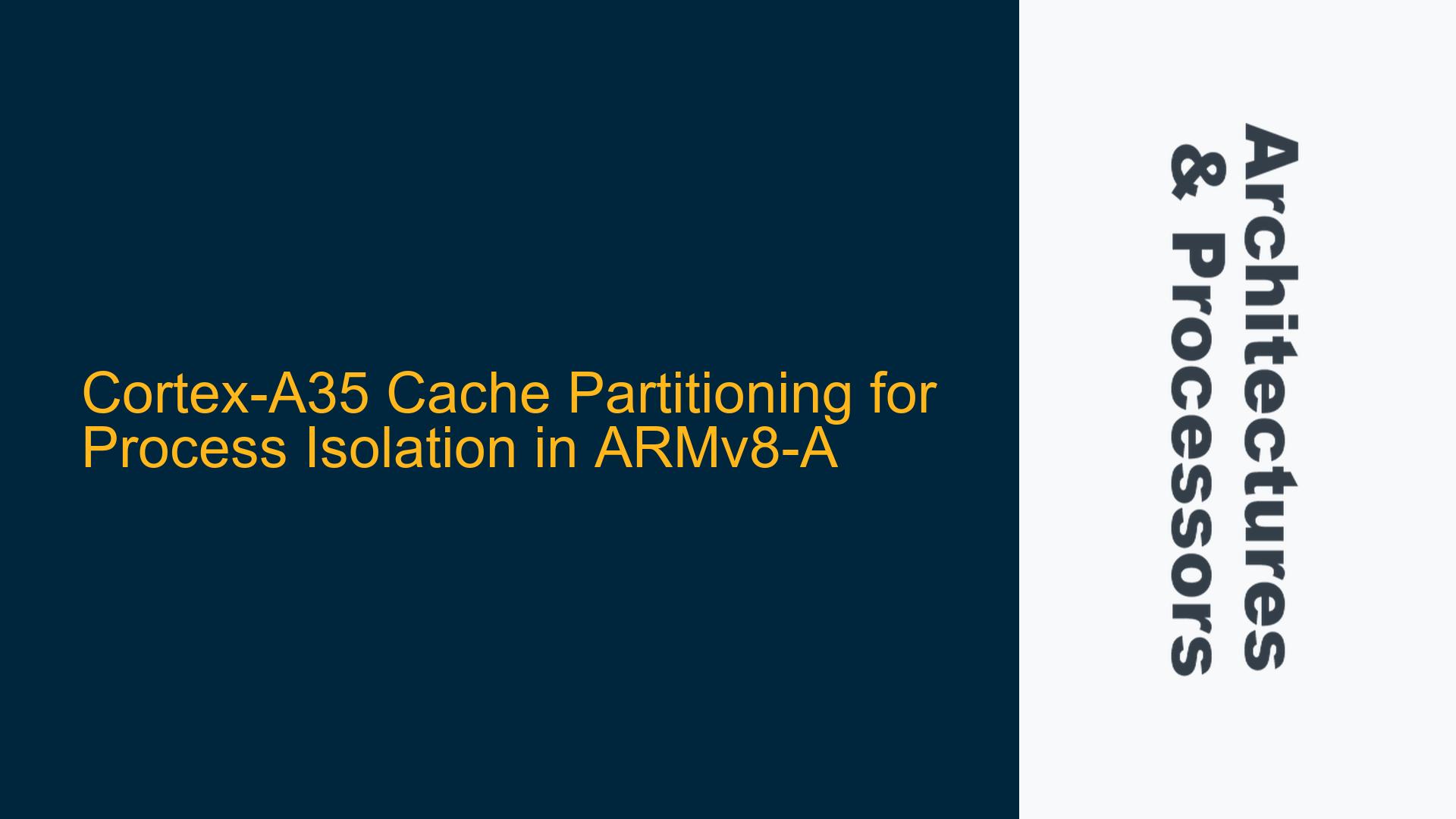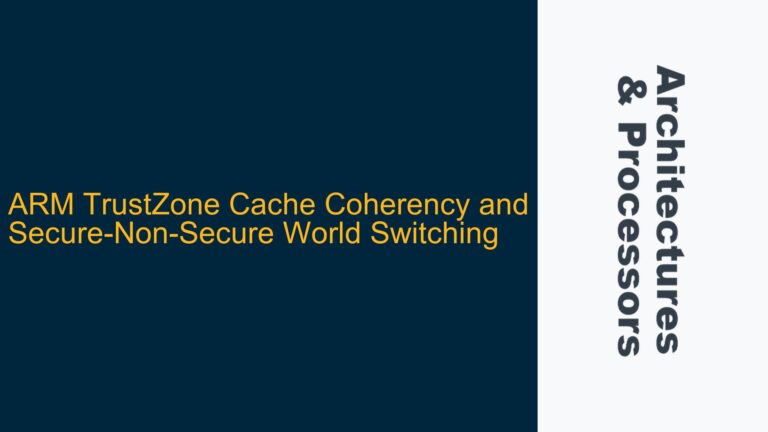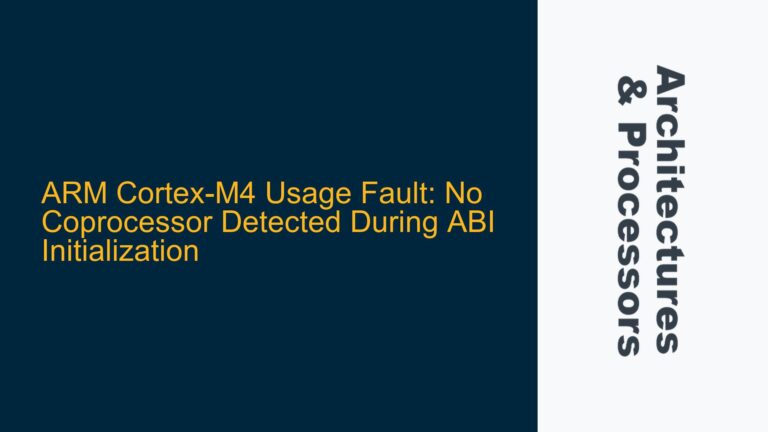ARM Cortex-A35 Cache Partitioning Challenges for Process Isolation
The ARM Cortex-A35 processor, based on the ARMv8-A architecture, is widely used in embedded systems for its power efficiency and performance. However, one of the challenges faced by developers is ensuring process isolation in the shared L2 cache to prevent interference between processes. This is particularly critical in safety-critical systems where deterministic behavior is required. The Cortex-A35 does not support cache lockdown, a feature that would allow specific cache sets or ways to be reserved for particular processes. This limitation necessitates alternative approaches to achieve cache partitioning and ensure that processes do not evict each other’s data from the cache.
Cache partitioning is essential for maintaining system reliability and performance, especially in multi-process environments. Without proper partitioning, one process could inadvertently cause cache thrashing for another, leading to unpredictable latency and potential system failures. The Cortex-A35’s L2 cache is physically indexed, which opens up the possibility of using techniques like cache coloring. However, the absence of cache lockdown mechanisms complicates the implementation of precise cache partitioning strategies.
Cache Coloring and Physically Indexed Caches in ARMv8-A
Cache coloring is a technique that leverages the physical indexing of caches to partition them logically. In the Cortex-A35, both the L1 and L2 caches are physically indexed, meaning that the cache index is derived from the physical address rather than the virtual address. This characteristic makes cache coloring a feasible approach for partitioning the cache. Cache coloring works by dividing the physical address space into distinct regions, or "colors," and assigning each process to a specific color. By doing so, each process is confined to a particular subset of the cache, preventing interference with other processes.
The effectiveness of cache coloring depends on the granularity of the partitioning and the ability to map processes to specific cache regions accurately. In ARMv8-A, the page tables can be configured to enforce this mapping by aligning the physical addresses of memory pages with the desired cache partitions. For example, if the L2 cache is 512KB and divided into two partitions of 256KB each, the page tables can be set up so that Process 1 uses physical addresses that map to the first 256KB of the cache, while Process 2 uses addresses that map to the second 256KB.
However, cache coloring is not without its challenges. One of the primary issues is the need for precise control over memory allocation to ensure that processes do not inadvertently cross into each other’s cache partitions. This requires careful management of the memory allocator and page tables, as well as a deep understanding of the cache’s indexing function. Additionally, cache coloring may not be sufficient on its own to guarantee complete isolation, especially in systems with complex memory access patterns or shared resources.
Implementing Cache Partitioning with Page Coloring and Memory Management
To implement cache partitioning using page coloring on the Cortex-A35, developers must first understand the cache’s indexing and tagging mechanisms. The L2 cache in the Cortex-A35 is typically organized into sets and ways, with each set containing multiple cache lines. The cache index is derived from the physical address, and the cache tag is used to identify the specific cache line within a set. By aligning the physical addresses of memory pages with the cache’s indexing function, developers can ensure that each process is confined to a specific set of cache lines.
The first step in implementing cache partitioning is to determine the cache’s organization, including the number of sets and ways, as well as the size of each cache line. This information can usually be found in the processor’s technical reference manual. Once the cache’s organization is understood, the next step is to configure the page tables to align memory allocations with the desired cache partitions. This involves setting up the page tables so that the physical addresses of memory pages map to specific cache sets or ways.
For example, if the L2 cache is 512KB and divided into two partitions of 256KB each, the page tables can be configured so that Process 1 uses physical addresses that map to the first 256KB of the cache, while Process 2 uses addresses that map to the second 256KB. This can be achieved by carefully selecting the base addresses of memory allocations and ensuring that the page tables are set up to enforce the desired mapping.
In addition to configuring the page tables, developers must also ensure that the memory allocator is aware of the cache partitioning scheme. This may require modifying the memory allocator to allocate memory from specific regions of the physical address space that correspond to the desired cache partitions. For example, if Process 1 is assigned to the first 256KB of the cache, the memory allocator should only allocate memory from the corresponding region of the physical address space.
Once the cache partitioning scheme is in place, developers must monitor the system to ensure that the partitioning is effective and that processes are not inadvertently crossing into each other’s cache partitions. This may involve using performance monitoring tools to track cache usage and identify any potential issues. If problems are detected, developers may need to adjust the cache partitioning scheme or modify the memory allocator to better enforce the desired partitioning.
In conclusion, while the Cortex-A35 does not support cache lockdown, cache partitioning can still be achieved using techniques like cache coloring. By carefully configuring the page tables and memory allocator, developers can ensure that each process is confined to a specific subset of the cache, preventing interference and improving system reliability. However, implementing cache partitioning requires a deep understanding of the cache’s organization and careful management of memory allocations, making it a complex but essential task for ensuring process isolation in safety-critical systems.






